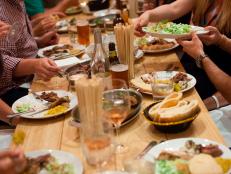10 Fascinating New Year Traditions Around the World
Swinging fireballs and dressing as demonic creatures are some of the unusual ways different cultures observe the New Year.
Related To:
lessRelated To:
Early Origins
Food, fortune, fire and/or demons have been recurring New Year's themes throughout the ages, regardless of the culture. Some of this commonality can be traced to the winter solstice, an ancient ritual marking the shortest day of the year around the end of December. But celebrating a new year also has its roots in the vernal equinox, once celebrated by many societies in March. Both early periods have contributed to the fascinating, and seemingly odd, cultural traditions that are still observed today.
Brazil
Brazil practices a host of New Year traditions, like wearing all white on New Year’s Eve — except for underwear or bathing suits. Those must be a symbolic color, such as green for health or red for love. But one of the most unique traditions happens throughout the day, when locals head to the beach to send white flowers and floating candles adrift to the sea goddess Iemanjá. Come midnight, beaches are packed with revelers (Copacabana Beach in Rio de Janeiro, pictured, is the most popular). While there, it’s also customary to jump over seven different waves while making a wish each time.
Spain
Eating 12 grapes at midnight on New Year’s Eve has long been associated with good luck. Ideally, you’re supposed to eat one along with each of the 12 bell chimings for the most luck. Grape eating dates back to at least the 1880s, and possibly copies the French tradition of ending the year with grapes. White Aledo grapes are the preferred celebratory grape, although their seeds slow down the scarfing process.
Scotland
Hogmanay is the Scottish version of New Year’s, stemming from when the Vikings celebrated the winter solstice. Today, it’s a three-day-long ordeal starting with a massive torchlight procession on December 30 and ending with a polar bear plunge, called the Loony Dook, on January 1. But arguably the most fascinating aspect of Hogmanay is the Stonehaven Fireballs on New Year’s Eve. Just before midnight a group of people parade through Stonehaven (near Aberdeen) swinging fireballs over their heads, a nod to an ancient fire purification ritual meant to eliminate evil spirits.
Columbia
Suitcases are among the Columbian New Year traditions that are especially relatable. In particular, the tradition of pulling a suitcase around the neighborhood at midnight on New Year’s Eve in order to increase the odds of a year filled with travel and adventure. Extra points for running, which most people do, but at least suitcases can be empty.
American South
Hoppin’ John is a beloved Southern dish, stemming from the days of slavery, traditionally consisting of black-eyed peas, hog jowl, rice and celery. At some point eating this dish on New Year’s Day became associated with good luck. One theory dates back to the Civil War, when black-eyed peas were among the foodstuffs that Union soldiers didn’t take. Another theory involves the Emancipation Proclamation, which went into effect on January 1, 1863, and black-eyed peas were one of the limited foods available for slaves to eat in celebration. Today, for the best luck, the dish should contain exactly 365 peas.
Japan
Japan boasts a long list of New Year’s Eve and New Year’s Day traditions. One of the main traditions revolves around hatsumode, when (seemingly) everyone visits a shrine or temple on January 1. This is preceded by spending midnight on New Year’s Eve at a Buddhist temple or Shinto shrine for the ceremonial bell ringing. This involves ringing a bell 107 times, and then once more at midnight. The number 108 holds special significance, and each bell represents a temptation to be purified. Most temples use a monk (or monks, depending on the size of the bell), for the ritual ringing, but a smaller number allow the first 108 people to each ring the bell once. Meiji Shrine in Tokyo and Fushimi Inari Taisha in Kyoto are among the most popular, but there’s no shortage of temples and shrines.
Denmark
Greeks aren’t the only culture to have a plate-breaking tradition (although not during New Year’s). Across Denmark, plates are traditionally smashed against friends’ doors at midnight on New Year’s Eve. This old ritual is meant to symbolize good luck (and show how many friends you have). The more plates, the more luck — and also the more mess to clean up on New Year’s Day.
Germany
Lower Bavaria has maintained a peculiar tradition for centuries that involves dressing as the stuff of nightmares in order to ward off demonic spirits. Rauhnacht (the exact origin meaning is unknown), goes down between December 21 and January 6, a period of time when bad spirits are believed to be at their most active. To combat this, locals carry torches while wearing getups made of fur and animal skins, a sight you can still see in towns across the region.
Greece
Pomegranates have represented good fortune since ancient times, and remain a common cultural symbol. So little surprise that they’re incorporated into New Year’s: On New Year’s Day pomegranates are taken to church to be blessed, then brought home and smashed against the front door or on the ground for good luck — the messier, the better, as the seeds represent abundance. Another variation involves turning off the lights and heading outside on New Year’s Eve, then smashing the pomegranate at midnight.
Philippines
Anything round is associated with coins, and hence, money and good fortune, so wearing polka dot outfits is a huge deal during New Year’s celebrations. But round anything will do the trick, and serving 12 different round fruits during New Year’s Eve dinner, from apples to oranges, is another annual tradition.





